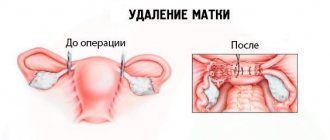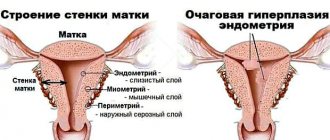Gynecological diseases occupy a leading position among all diseases of the female half of the population. Sooner or later, every representative of the fair sex, regardless of age, becomes closely acquainted with some gynecological disease. This may be a hormonal imbalance in the female body, cervical erosion, polycystic ovary syndrome, fibroids, endometritis, inflammation of the ovaries and appendages and many other diseases.
Many gynecological pathologies, especially those occurring in women over 50–60 years of age, entail severe consequences. Thus, if in women of reproductive age the most common complication of gynecological diseases is serious problems with conception, including infertility, then in older women there is most often a risk of the pathology degenerating into a malignant neoplasm.
In the treatment of gynecological diseases, it is not always possible to achieve positive results only through conservative treatment. In advanced stages of disease, drug therapy is not always effective enough, so in some cases there is a need for surgical removal of the ovaries. Women who are about to have their ovaries removed panic and ask questions: what consequences will such an operation bring them and is it possible to return to an active, fulfilling life after removal of the ovaries?
Introduction and background epidemiology
The content of the article:
Ovarian cysts are quite common in postmenopausal women over 60 years of age. The exact figure is unknown given the limited amount of published data and the lack of established screening programs. However, studies have estimated the incidence to be somewhere between 5% and 17%. The increased use of ultrasound in gynecological practice and the widespread use of other imaging modalities such as computed tomography (CT) and magnetic resonance imaging (MRI) have recently increased the proportion of incidentally discovered cysts in women over 60 years of age.
However, cystic lesions are considered significant if they are 1 cm or larger in size. Cystic lesions less than 1 cm in size are clinically insignificant and it is at the discretion of the reporting clinician whether or not to include them in the imaging report. Laparoscopic techniques are used to further examine and determine which are benign and those that are potentially malignant.
Diagnosis and significance of ovarian cysts
When initially diagnosing ovarian cysts in women over 60 years of age, it is recommended to start with measuring the level of serum antigen 125 (CA125) and a transvaginal ultrasound scan of the pelvic organs.
Where the initial imaging modality was a CT scan, unless this was clearly suggestive of ovarian malignancy and widespread intra-abdominal disease, an ultrasound scan should be performed to calculate a risk malignancy index (RMI). A detailed medical history is also taken from the woman, with particular attention to risk factors for a family history of cancer, bowel or breast cancer. High risk is determined if she has a first-degree relative (mother, sister, daughter) with cancer.
Surgical menopause after hysterectomy
Menopause after surgery and removal of the uterus leads to a number of systemic changes in a woman’s body, namely:
- there is a violation of feedback between individual parts of the brain and the ovaries (if they are preserved);
- the level of blood supply in the pelvic area and in the ovaries themselves changes, which affects their overall performance;
- the woman’s psychological state is disrupted: a feeling of inferiority begins to prevail, that during the accompanying menopause the uterus and ovary were removed, and they will not provide further opportunities for leading a normal lifestyle, which is not at all the case.
After uterine surgery, the menopause is characterized by the following signs:
- There is no menstrual discharge, since the basis of discharge during menstruation is the endometrium, then after removal of the uterus it simply does not exist.
- There is no possibility of childbearing, since the removed uterus is an organ for the development of the fetus, and in its absence it is impossible to get pregnant.
- Nervousness. This is explained by the fact that during a hysterectomy in a young woman who was planning a pregnancy, the inability to give birth to a baby becomes a huge stress, which is accompanied by depression, aggressiveness and tearfulness. But for women in adulthood who already have children, the impossibility of pregnancy is a unique advantage, because now there is no need to think about an unplanned and sudden pregnancy. Against this background, menopause is characterized by increased libido and a balanced psycho-emotional state.
Manifestations of menopause after hysterectomy
Menopause after surgery to remove the uterus is in some ways easier to bear than if the organ is preserved. The main advantage is the complete absence of various vaginal discharge and menstruation with annoying pads. But determining the onset of the obvious moment of menopause is complicated by this factor. Menopause when the uterus is removed is manifested by the following symptoms:
- hot flashes occur, which are characterized by changes in the condition of blood vessels. The aging process overtakes them very quickly, as the blood supply is disrupted due to the missing uterus. Therefore, sensations of heat occur in an acute form and appear very often. It is also possible to quickly gain excess weight, which is a characteristic sign of surgical menopause in women. And the gained kilograms contribute to the formation of high blood pressure and impaired heart function;
- changes in the urogenital area. The absence of the cervix, in which the so-called “lubrication” was produced, leads to atrophy of the mucous surfaces in the vagina and bladder. Surgical menopause can cause prolapse of the vagina and bladder, which can lead to difficulty urinating, incontinence, and pain during sexual intercourse with a partner.
- When the uterus is removed, very often women are faced with a problem such as osteoporosis, that is, thinning of bone tissue.
The scope of surgical interventions when performing surgery on a woman’s reproductive organs, depending on the development of the disease, can be different:
- Performing a supravaginal hysterectomy, that is, removing the appendages, but completely preserving the uterine organ. Menopause after removal of the appendages with the uterus intact is manifested by a sharp drop in estrogen levels.
- Performing a general hysterectomy, that is, complete removal of the reproductive organs: the uterus itself, ovaries, appendages and fallopian tubes are removed. The onset of menopause after removal of the uterus and appendages greatly affects the patient’s sexual desire and general health. Therefore, it is very important in the postoperative period to carry out full therapeutic treatment with special medications prescribed by the attending physician.
- Radical hysterectomy is characterized by the elimination of the cervix, uterus, its appendages, as well as pelvic tissue, lymph nodes and the upper part of the vagina, which leads to a change in the location of all organs in the pelvic region. It is recommended that patients, after menopause occurs when the uterus and appendages are removed, perform a set of exercises to strengthen the pelvic floor.
Menopause after hysterectomy surgery of any complexity can be accompanied by a number of complications:
- the processes of urination and urinary retention are disrupted;
- thermoregulatory processes in the body are disrupted;
- Heavy bleeding may develop;
- formation of purulent compartments on the suture line, etc.
When menopause occurs after removal of the uterus, treatment should be combined and always timely. You should not endure unpleasant symptoms. The sooner treatment is started, the faster the body will return to normal.
After a hysterectomy, it is necessary to limit physical activity and adjust your diet to prevent rapid gain of extra pounds. When surgical menopause begins in women, treatment should be tailored to the individual characteristics of each patient.
Doctors have found that when the uterus is removed, menopause occurs several years earlier than under natural conditions, even if the ovaries are preserved. And menopause with the uterus and ovaries removed can occur up to 7 years earlier than expected.
Symptoms
Often functional cysts do not show any specific symptoms. You may have them and not know it. But the formation of ovarian cysts after 60 and other types is possible. Be sure to contact your doctor when the first symptoms appear.
In other cases they may include:
- Sharp or dull pain in the lower abdomen, usually on one side.
- Bloating.
- Nausea and vomiting.
- Feeling full after eating a small amount.
- Constipation.
conclusions
But not everything is as scary as it seems . The fact is that the body is able to compensate for the lack of sex hormones with the help of the adrenal glands and adipose tissue, which partially compensate for the lack of estrogens, progesterone and androgens. And taking hormonal medications helps to completely restore hormonal imbalances in the body. At the same time, a woman can always remain healthy, beautiful, and feel great, even with her ovaries removed.
However, all this is achieved not only by taking medications, but also by the woman’s own efforts . Under no circumstances should you give up and let yourself go. It is necessary to avoid depression and follow the above recommendations and the advice of your doctor.
Sources:
https://vklimakse.ru/udalenie-yaichnikov-pri-menopauze.html https://estet-portal.com/doctor/statyi/chto-proiskhodit-posle-udaleniya-yaichnikov-i-pri-menopauze https:// plusiminusi.ru/posledstviya-udaleniya-yaichnikov-u-zhenshhin/
Causes and risk factors
The most common causes of ovarian cysts after age 60 include:
- It is caused by hormonal problems and may also be affected by the hormonal medications you take.
- Women diagnosed with a condition called endometriosis may develop a type of cyst called an endometrioma. This is when endometriosis tissue attaches to the ovary and forms a growth.
- Pelvic infections. Severe infections can spread to the ovaries and cause cysts to form. Polycystic ovary syndrome. This is a disease in which the ovaries form many small structures.
Characteristics of post-castration syndrome
- The main role in post-castration syndrome is played by vegetative-vascular disorders. These most often include the so-called “hot flashes”, sudden changes in blood pressure, tachycardia, pain in the heart, and increased sweating.
- Various disturbances in the functioning of the endocrine system, failures of metabolic processes. Most often they are expressed in the form of obesity or hyperlipidemia.
- The consequences of a psycho-emotional nature in women are apathy, irritability, sleep disturbances, sudden mood swings, tearfulness, loss of interest in life, aggressiveness.
Other signs of post-castration syndrome in women over 50 appear much later. A deficiency of female sex hormones, in particular estrogen, negatively affects the functioning of the genitourinary system. This can be expressed in the development of cystitis, colpitis, cystalgia. In addition, the lack of estrogen and progesterone has the most deplorable effect on a woman’s appearance - the skin quickly loses its elasticity and ages, hair becomes brittle and lifeless, and begins to fall out rapidly. Women experience thinning and brittleness of nails and teeth, increased dryness of the skin and mucous tissues.
Treatment
Functional cysts very often shrink over time, usually after 1 to 3 months. If you are diagnosed with this type, your doctor will definitely want to check you again in 1-3 months to make sure that it has decreased or completely gone away. Is surgery necessary for diagnosing an ovarian cyst after 60 years of age? Treatment will depend on several things. This includes your age, size, appearance of the mass, and your symptoms.
You may need surgery if:
- It's getting bigger.
- Looks unusual on a sonogram.
- Causes pain.
What type of surgery will you need?
Most likely you will be recommended a laparotomy. If the mass looks too large to remove with a laparoscope, or if it looks suspicious, your doctor will likely do a laparotomy. This surgery uses a larger incision to remove the cyst. She is then tested for cancer. If it is cancerous, you may have to remove the ovary and other tissue. This may include the fallopian tubes, or the uterus. It is very important to talk to your doctor about all of this before surgery.
Your doctor will tell you the risks of each type of surgery. He or she will tell you how long you will be in the hospital and how long it will be before you can return to your normal life.










